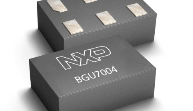New GPS LNAs resist jamming
on

NXP Semiconductors has released a new family of SiGe:C low noise amplifiers (LNAs) designed to improve the linearity, noise figure and reception of GPS signals, including GloNass and Galileo, while offering the smallest footprint in the market. A unique capability of the BGU700x family of GPS LNAs is dynamic gain adaptation to improve reception of weak GPS signals in the presence of strong signals from mobile phone, Bluetooth or WLAN transmitters. This improves IP3 by 10 dB or more under -40 to -20 dBm jamming conditions, with the noise figure remaining below 1 dB.
GPS signal levels are weak and below the noise floor at -155 dBm. In many GPS-enabled products, especially smartphones, strong signals for Bluetooth, WLAN or phone service can drive the GPS LNA into compression, thereby reducing its gain and impairing GPS reception. This also generates intermodulation products and harmonics from the received signals, which may overpower weak signals and lead to loss of GPS reception. The BGU700x devices immediately detect power from jamming signals and compensate by temporarily increasing the operating current to maintain optimal GPS signal reception as long as possible.
BGU700x LNAs also save up to 50% in PCB size and 10% in component cost. Each device requires only one input matching inductor and one supply decoupling capacitor to complete the design. For example, the BGU7005 in a 1.45 x 1 mm package has an application area of only 4.5 mm². Available in extremely small 6-pin packages, the new LNAs reduce footprint, lower cost, and enhance reception in systems that use an active or patch antenna.
BGU700x devices feature a noise figure of 0.75 dB and system-optimized gain of 16.5 or 19 dB, and some members of the family (BGU7004 and BGU7008) are AEC-Q100 qualified for high reliability under harsh conditions.
Image: NXP


Discussion (0 comments)